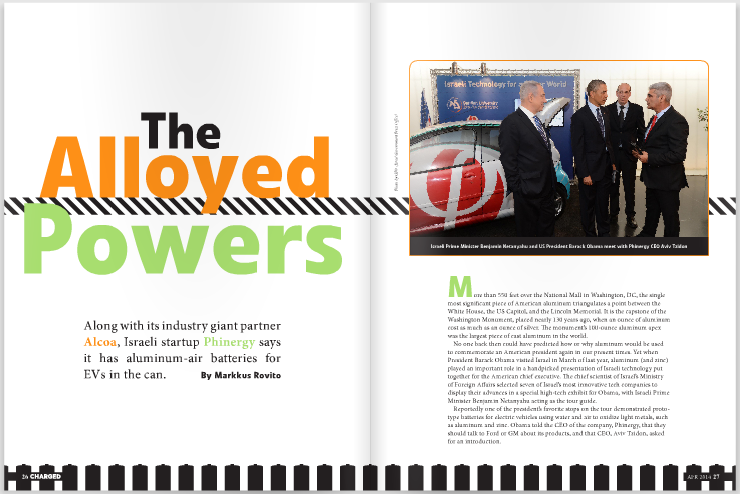Along with its industry giant partner Alcoa, Israeli startup Phinergy says it has aluminum-air batteries for EVs in the can.
More than 550 feet over the National Mall in Washington, DC, the single most significant piece of American aluminum triangulates a point between the White House, the US Capitol, and the Lincoln Memorial. It is the capstone of the Washington Monument, placed nearly 130 years ago, when an ounce of aluminum cost as much as an ounce of silver. The monument’s 100-ounce aluminum apex was the largest piece of cast aluminum in the world.
No one back then could have predicted how or why aluminum would be used to commemorate an American president again in our present times. Yet when President Barack Obama visited Israel in March of last year, aluminum (and zinc) played an important role in a handpicked presentation of Israeli technology put together for the American chief executive. The chief scientist of Israel’s Ministry of Foreign Affairs selected seven of Israel’s most innovative tech companies to display their advances in a special high-tech exhibit for Obama, with Israeli Prime Minister Benjamin Netanyahu acting as the tour guide.
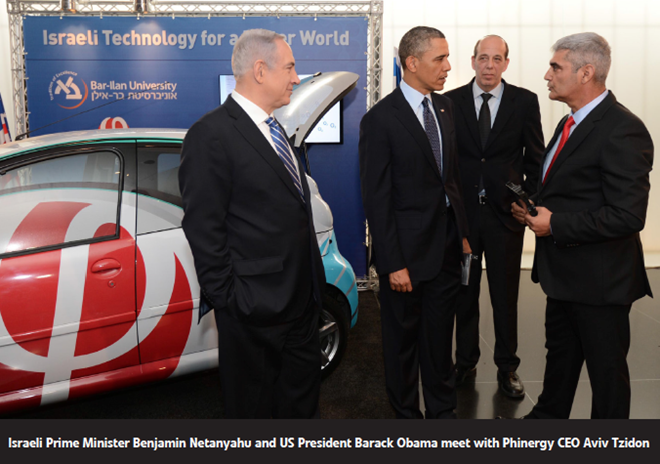

Reportedly one of the president’s favorite stops on the tour demonstrated prototype batteries for electric vehicles using water and air to oxidize light metals, such as aluminum and zinc. Obama told the CEO of the company, Phinergy, that they should talk to Ford or GM about its products, and that CEO, Aviv Tzidon, asked for an introduction.
A recycled technology
At the time of President Obama’s Israeli trip, Ford and GM probably didn’t have much of a clue about Phinergy. The company had just started to poke its head out of “stealth mode,” and into the public view. However, any company with a toe or two dipped into the waters of vehicle electrification had some awareness of metal-air batteries as a failed technology of about 25 years prior. Metal-air had everyone’s attention because of its enormous energy potential, but it was largely written off because no one had been able to create an air electrode with a lifespan much longer than 100 hours. The electrodes suffered carbonization problems from not being able to adequately isolate oxygen from the air.
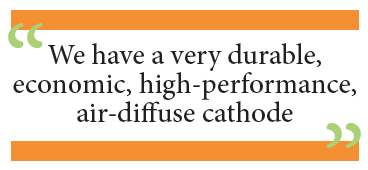

However, companies like Phinergy represent the brave new world of 21st-century nanotechnology, in which old limitations smash up against a wall of new-fangled materials. Phinergy’s first patent was for what it calls a nano-porous silver-based catalyst, which lets oxygen into the electrode and the cell while effectively blocking CO2. Tzidon told Charged that Phinergy’s invention has enabled its metal-air cathode to demonstrate an ongoing 25,000 working hours. “We have a very durable, economic, high-performance, air-diffuse cathode,” Tzidon said.
The challenge in making Phinergy’s catalyst material was to maintain the highest possible surface density. The researchers found that pushing the nano-particles together would begin to reduce surface area, because the particles had the tendency to center. So instead of monitoring particle size, they monitored the distance between the particles and created a sponge-shaped structure with a continuously monitored surface area and a spacing between particles of 1-2 nm. “The separator does not allow the particles to merge together,” Tzidon said. “The mechanical spacer allows us to compress and get good connectivity by not losing surface area.”
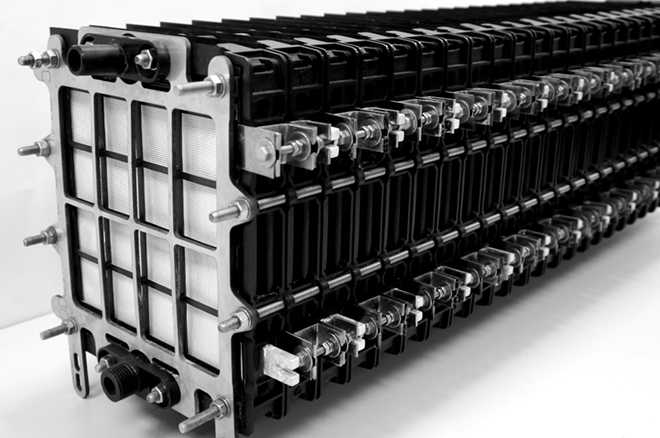

This initial IP gave Phinergy a few advantages to build on. For example, a silver-based catalyst – the price of silver runs at about two percent that of comparable platinum, and silver is easy to recycle.
More importantly, with its stable air electrode, any Phinergy metal-air battery would not have to use pure oxygen, as is the case with most lithium-air technologies. That leads to huge reductions in battery size and weight. In a conventional battery using oxygen as the cathode, 60-80 percent of the battery’s volume comes from the cathode, because of the heavy materials that bind oxygen inside it. Phinergy’s technology can breathe oxygen from ambient air, allowing a high-capacity battery with low weight, and a cathode component that takes up about the same space as the electrolyte and metal anode components.
“The air-diffuse cathode has Teflon on the outside, so it breathes air,” Tzidon said. “From the inside, there is our nano-structure catalyst covering the aluminum on both sides. The reaction creates electricity while consuming aluminum.”
Besides just nanotechnology, Tzidon lists other benefits Phinergy now enjoys that the previous generation did not. Integration with computers, microchips, and microcontrollers all count as big factors. “Today on a chip you can do many things that 20 years ago you needed a whole rack of processors to do the same task,” Tzidon said. “Even lithium chemistry was available 20 years ago, but today’s lithium-ion without a battery management system – a tiny chip per cell – would not survive.”
Tzidon also points out that there is greater emphasis on a multidisciplinary approach to R&D today than there was before. There is more fluidity in looking for solutions along the lines of pure chemistry, computer control, packaging, rapid prototyping, etc.
Phinergy’s wake
Based on its initial patent, Tzidon founded Phinergy in 2008, but the technology originated all the way back in 2000 at the Bar-Ilan University in Israel. The main focus has been on aluminum-air batteries, but in 2010 Phinergy also started working on zinc-air, which Tzidon says differs in energy density and the fact that zinc-air can be a secondary battery, while aluminum-air is a primary battery.
Phinergy now has an additional 18 patents pending. “They are all associated with the kinds of hurdles that in the past were killers,” Tzidon said. “Today there are ways to walk through the difficulties.”
While Phinergy is developing products for a range of applications, including consumer electronics, stationary energy storage, aerospace, and defense, the company is concentrating heavily on EVs. It’s a refreshing change of pace, because so often battery innovators need to break into electronics before scaling up to vehicles. Because the bottleneck with aluminum-air was not its energy density, cycle life, recharge rate, etc., it could be introduced to EVs early on once it was viable.
“From a business standpoint, we could look at our generator and start from the easiest to the most difficult, meaning starting with stationary storage, data center back-up, etc., where you don’t care about footprint,” Tzidon said. “But we decided to shape the technology to the most extreme environment: the car, which is mobile, crash-proof, small, etc. It’s more complicated to demonstrate the car than to demonstrate a generator. The reason we went to the extreme solution was mainly to break the negative stigma associated with the failure of 20-something years ago. People who remember it will be skeptical. They don’t remember why it failed – they just remember ‘it will never work.’”
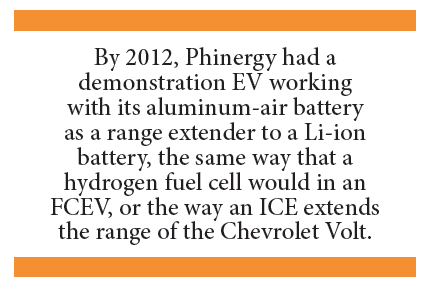

Of course, that stigma falls apart if one sees that it does work. By 2012, Phinergy had a demonstration EV working with its aluminum-air battery as a range extender to a Li-ion battery, the same way that a hydrogen fuel cell would function in an FCEV, or the way an ICE extends the range of the Chevrolet Volt.
That set the stage for Phinergy’s breakout year in 2013, when it finally began to go public with the results of 13 years of work. In early 2013, Phinergy signed a joint development agreement with aluminum giant Alcoa to get its aluminum anode up to an affordable commercial scale, and it also got its first major OEM contract from Renault-Nissan. “We wanted to be as mature as possible and as ready to commercialize as possible, before making public announcements,” Tzidon said.
Phinergy has now set a schedule to have a commercially-available car using its aluminum-air technology as a range extender, and to do so, it will need a lot of help from its biggest partner.
Alcoa can’t wait
The same year that the Washington Monument opened to the public, 1888, Charles Martin Hall founded Alcoa, then known as the Aluminum Company of America. As Douglas Ramsey, Business Development, Breakthrough Technologies at Alcoa told Charged, “we invented the aluminum industry. Our founder created an industrial-scale process to drive the price down.” Since then, Alcoa has become the largest and possibly only completely vertical aluminum company that does the entire process of mining, refining, smelting, rolling, casting, and final end-product integration of aluminum. The company had revenue of $23 billion in 2013.
“Air-aluminum was an area of interest to us cyclically over the last few decades, and we’ve continued to track it,” Ramsey said. “Discovering what Phinergy was doing was a revelation. Our ability to take our expertise from the last few decades and apply that to the system under development at Phinergy has allowed us to get very quickly over the past 12 months to the point where we have a viable, very competitive solution for commercial automotive and other applications.”
Alcoa’s job in the partnership is essentially to perfect the fuel, aluminum. Tzidon likens the type of aluminum used in Phinergy’s system to the octane in gasoline – there are different alloys that could work. These alloys are special to the process, but not as complicated as aerospace materials. They are made by rolling, similar to the way automotive sheet enclosures are made. Alcoa works on mass-producing the most efficient aluminum for the most competitive price, and that price would be essentially anything less than the price of gas per mile.
How it works
Not only does Phinergy want the cost of its aluminum-air batteries to have a price equal to or less than gas, but the company also wants the user experience to be as easy as operating an ICE vehicle or a PHEV.
“We are trying to do this technology without the need to educate the customers,” Tzidon said. “If you introduce a new technology, and it is too revolutionary, you might lose in the game. You should do a step at a time. We’re trying to initiate a petrol-like solution, where every 10
days or more you go to a gas station. So, you go less often.”
Why would you need to go to a gas station? It’s for the occasional times that you need to swap out the water. Phinergy’s aluminum-air battery releases energy from the aluminum when it reacts with water and air. For every 1 kg of aluminum, you need 1 liter of water and 1 kg of oxygen from ambient air, and the reaction creates a waste product of approximately 3 kg of aluminum hydroxide, which later can be reused or recycled back into aluminum. If you plug in the car to recharge the Li-ion battery, the electricity can also replenish some of the aluminum-air battery’s electrolyte (water). However, after driving long distances on aluminum-air, the electrolyte will be soaked with dissolved aluminum, and you will need to swap it out. Tzidon thinks existing gas stations could do that easily. Onboard filtration will take out active elements such as chlorine before feeding it to the battery, so you could fill it with tap water from a sink, garden hose, or wherever.


“We are working on a scheme whereby the gas station will take the valuable aluminum hydroxide, and refill the water or regenerate your electrolyte,” Tzidon said. “We don’t know the process yet, but the waste has value. So instead of the gas station charging you for petrol, they will assist you, charging us for collecting the material. This replacement is equivalent in time to fast charge or battery replacement. You download 20 gallons, and you upload 20 gallons. In the gas station, there is a machine pump we give them that filters your used electrolyte. It splits aluminum hydroxide to the left and fresh electrolyte to the right. Then a new customer comes in and takes yesterday’s electrolyte that was refurbished at night. That 20 gallons of water will be equivalent to another 300-400 miles from the aluminum-air battery. So you have the lowest complexity we can imagine influencing the infrastructure. Hydrogen fuel cells are not so simple; fast charge is huge in terms of [power] that you need; and battery swap is not easy to do.”
As the other piece of maintenance, the aluminum will need to swapped out, which Tzidon believes can be done during the regularly scheduled annual check-up for a car. The idea for the Phinergy range extender is that it would be used about as much as the Chevy Volt ICE range extender, or about 10-15 percent of the total miles driven. Tzidon listed the theoretical specific energy of Phinergy’s aluminum-air as 8.1 kWh per kilogram of aluminum. The company’s current iteration achieves 3.5 kWh per kilogram. Its production roadmap anticipates increases in that number, but even at its current level, a battery with 100 kg of aluminum would provide around 2,000 miles of driving, depending on the vehicle. Tzidon expects that to be enough for a typical driver going 20,000 miles a year.
Meanwhile, the large back-up range extender eliminates range anxiety for a pure EV without the need for a huge, heavy, expensive 300-mile Li-ion battery that most drivers will only use to capacity a few days per year. Aluminum-air has no self-discharge. Phinergy also claims substantial potential reductions in the total volume, weight, and price of the overall battery system when you replace part of a large Li-ion battery pack with an aluminum-air range extender. For every kilogram of Li-ion battery that an OEM replaces with a kilogram of aluminum, that OEM gets 30 times the energy, according to Tzidon.


“We all know that one barrel of gasoline gives us around 1,000 miles,” Tzidon said. “One barrel of aluminum can give us about five times better. Instead of an internal combustion engine range extender, you have a silent, zero-CO2, cheaper-than-gasoline solution. It’s a win-win. You have a full electric car that uses the same computer to activate our range-extending device.”
Phinergy also plans on redirecting heat from its battery to heat the car when needed. “The efficiency of the aluminum reaction is about half electricity, half heat,” Tzidon said. “When we warm an electric car now, we lose range more dramatically, but whenever we activate the aluminum, we can warm the car. In Atlanta for example, that can save 230 kWh in a year, or in New York, 350 kWh.”
Any OEM choosing to work with Phinergy’s aluminum-air technology will be able to choose its own battery-size options according to its own needs. “This technology is eminently modular,” said Ramsey. “We can build this up to be a bank of 50 if needed. The OEMs have their own aperture they can design to.”
OEM OMG
During February’s Advanced Automotive Battery Conference 2014 in Atlanta, Tzidon presented Phinergy’s aluminum-air technology and issued calls to Tier 1 partners who could help accelerate the company’s path to volume production, as well as OEMs who want to use its batteries, joining Renault-Nissan, which was the first big automotive manufacturer to sign up. He touted selling points such as sustainability, safety, and pure economics. Phinergy won’t be satisfied until the cost of battery is less per mile than gasoline.


“Aluminum is eight percent of the earth’s crust; it’s the most abundant metal on earth,” Tzidon said. They can also create the aluminum in a smelter where electricity is cheap and abundant and then export it to where it’s needed.
“We are actually importing cheap, clean sustainable energy from Norway or Iceland, where you have so much energy but nothing to do with it,” Tzidon says. “You ship it in a tanker full of aluminum, and if the tanker sinks, nothing happens. It’s not like a catastrophe of oil in the ocean. It is safe; it can wait nearly forever. The way to look at aluminum might be as a solid-state reservoir of energy: 8 kWh in 1 kg of aluminum.”
The finished product is also protected from leakage. “We built a tank of electrolyte and connected it to the bottom and top of these cascade cells. By flowing the electrolyte in, we activate a generator. If the electrolyte is out, it is in a dry state, and it can stay in that position for many years. There is no leakage, because it is a battery with a missing connectivity between cathode and anode.”
An OEM using Phinergy’s aluminum-air technology will have an additional opportunity to generate customer loyalty and extra revenue by selling the customer new aluminum when they bring the car in for annual service, as well as by repurposing or recycling the waste aluminum hydroxide. “We learned with Alcoa that aluminum hydroxide can be used to create a very nice fire- and smoke-retardant material,” Tzidon said, adding that such a use could increase the value of aluminum hydroxide by as much as five times.
“The OEM likes this, because it can sell energy as spare parts in a value chain it usually is not part of. With fuel cells, they don’t get a piece of the action from the hydrogen, and they don’t get a piece of the action from the grid fueling the batteries.”
So an OEM could potentially profit directly from aluminum and aluminum hydroxide sales, but also indirectly from building up sustainability credentials. Tzidon wants Phinergy to maintain a holistic approach to reducing the carbon impact of its products, and he thinks that Alcoa is the best possible partner to discover the most sustainable manufacturing process. “It’s important for us to look at the issue of electrifying cars in such a way that the total CO2 footprint will be better than other solutions. When we look at other chemistries that have a nice capacity, we ask, ‘What is the total footprint to create one kilowatt, one mile, one lifecycle, etc.?’ This is important if we really want to improve the world.”
“We have an end-to-end, totally recyclable, zero-CO2, zero-emission, system,” said Ramsey, “along with the great visual of sticking the garden hose in your car to power up.”
All of the aforementioned factors can help to break the negative stigma that aluminum-air developed in its early formative years. In some ways, the past failure of metal-air batteries may eventually help Phinergy’s reputation when it validates, proves, and publicizes its technologies further. Even if aluminum-air remains notorious in some circles, it at least has name recognition that other emerging solutions may not. “There’s an understanding of aluminum-air’s potential within the automotive and power electronics communities,” Tzidon said. “People have been waiting for this moment when somebody says, ‘I’ve fixed the fundamentals on getting it to market, getting the fuel right, the design right, and the controls right.’” Consider it said.
This article originally appeared in Charged Issue 13 – APR 2014




